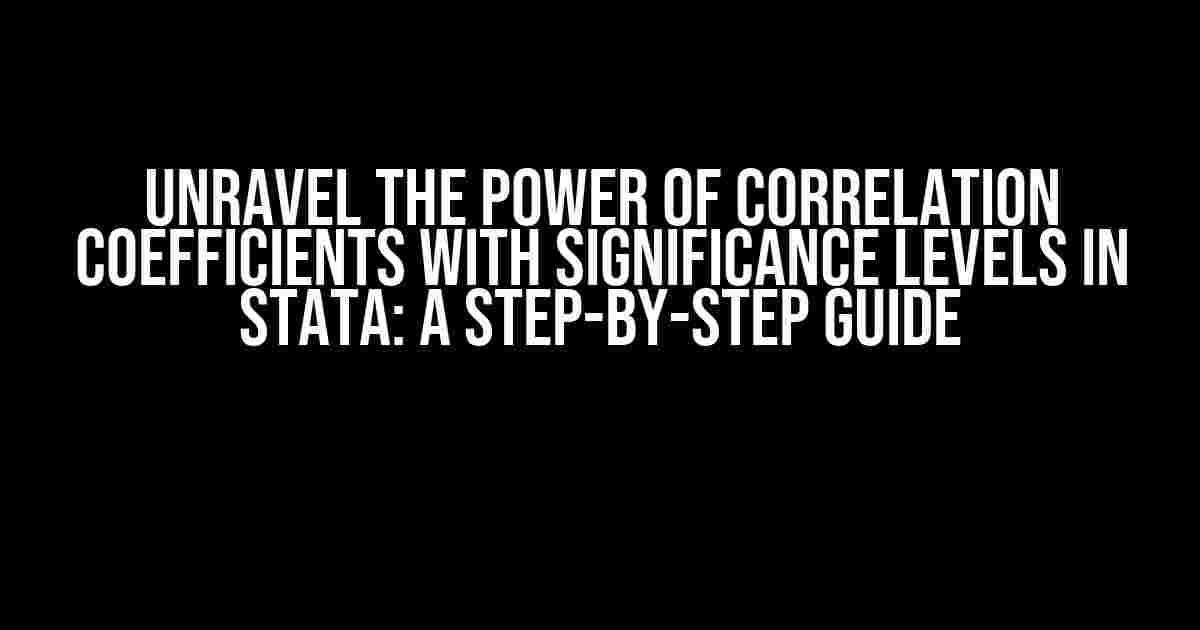Are you tired of drowning in a sea of correlation coefficients without a clear understanding of their significance levels? Look no further! In this comprehensive guide, we’ll demystify the process of getting formatted correlation coefficients with significance levels in Stata. By the end of this article, you’ll be able to confidently interpret and present your findings, giving you a edge in your research or analytics career.
Why Correlation Coefficients Matter
Correlation coefficients are a fundamental tool in statistical analysis, measuring the strength and direction of the linear relationship between two continuous variables. However, without significance levels, correlation coefficients can be misleading, making it difficult to determine whether the observed relationship is due to chance or a real effect.
The Importance of Significance Levels
Significance levels provide a crucial layer of context to correlation coefficients, indicating the probability of observing the coefficient by chance. A low significance level (typically ≤ 0.05) indicates that the observed correlation is statistically significant, suggesting a real relationship between the variables. On the other hand, a high significance level (> 0.05) implies that the correlation may be due to chance.
Getting Formatted Correlation Coefficients with Significance Levels in Stata
Stata, a popular statistical software, offers a range of commands to calculate correlation coefficients with significance levels. In this section, we’ll explore the step-by-step process of getting formatted correlation coefficients with significance levels in Stata.
Step 1: Load Your Data
use "your_data.dta", clear
Replace “your_data.dta” with the actual path and name of your Stata dataset file.
Step 2: Calculate Correlation Coefficients
corr variable1 variable2
Replace “variable1” and “variable2” with the names of the two continuous variables you want to correlate. This command will generate a correlation matrix containing the correlation coefficient (r) and the p-value (significance level).
Step 3: Format Correlation Coefficients with Significance Levels
corr variable1 variable2, stats(rho) fmt(%5.2f) pval
This command calculates the correlation coefficient (rho), formats it to have two decimal places (%5.2f), and includes the p-value (significance level) alongside the coefficient.
Step 4: Customize Your Output
corr variable1 variable2, stats(rho) fmt(%5.2f) pval matrow(names) matcol(names)
This command adds row and column names to the output matrix, making it easier to read and interpret.
Interpreting Your Results
Once you’ve generated the formatted correlation coefficients with significance levels, it’s essential to interpret your results accurately.
Understanding the Correlation Coefficient (r)
The correlation coefficient (r) ranges from -1 to 1, indicating the strength and direction of the linear relationship:
- r = 1: Perfect positive correlation
- r = -1: Perfect negative correlation
- r = 0: No correlation
- r > 0: Positive correlation
- r < 0: Negative correlation
Understanding the Significance Level (p-value)
The significance level (p-value) represents the probability of observing the correlation coefficient by chance:
- p-value ≤ 0.05: Statistically significant (reject the null hypothesis)
- p-value > 0.05: Not statistically significant (fail to reject the null hypothesis)
Common Applications of Correlation Coefficients with Significance Levels
Correlation coefficients with significance levels have numerous applications in various fields, including:
- Finance: Analyzing the relationship between stock prices and economic indicators
- Marketing: Investigating the correlation between ad spend and sales revenue
- Healthcare: Examining the relationship between patient outcomes and treatment variables
- Education: Studying the correlation between student performance and socioeconomic factors
Conclusion
In conclusion, getting formatted correlation coefficients with significance levels in Stata is a straightforward process that requires a basic understanding of statistical concepts and Stata commands. By following the steps outlined in this guide, you’ll be able to confidently calculate and interpret correlation coefficients, giving you a deeper understanding of the relationships between variables in your data.
| Command | Description |
|---|---|
| corr variable1 variable2 | Calculates correlation coefficient (r) and p-value between two variables |
| corr variable1 variable2, stats(rho) fmt(%5.2f) pval | Formats correlation coefficient with significance level |
| corr variable1 variable2, stats(rho) fmt(%5.2f) pval matrow(names) matcol(names) | Customizes output with row and column names |
Remember to replace “variable1” and “variable2” with the actual names of your variables in the commands above.
Frequently Asked Question
Get the most out of Stata by learning how to get formatted correlation coefficients with significance levels!
How do I get correlation coefficients with significance levels in Stata?
You can use the `corr` command with the `sig` option to get correlation coefficients with significance levels in Stata. For example, `corr x y, sig` will give you the correlation coefficient and significance level for the variables x and y.
How do I format the correlation coefficients with significance levels in Stata?
You can use the `format` option with the `corr` command to format the correlation coefficients with significance levels in Stata. For example, `corr x y, sig format(%3.2f)` will give you the correlation coefficient and significance level for the variables x and y, formatted to two decimal places.
Can I get the correlation coefficients with significance levels for multiple variables at once in Stata?
Yes, you can use the `corr` command with the `varlist` option to get correlation coefficients with significance levels for multiple variables at once in Stata. For example, `corr x y z, sig` will give you the correlation coefficients and significance levels for the variables x, y, and z.
How do I customize the output of the correlation coefficients with significance levels in Stata?
You can use the `out` option with the `corr` command to customize the output of the correlation coefficients with significance levels in Stata. For example, `corr x y, sig out(correlation_matrix)` will give you the correlation coefficients and significance levels for the variables x and y, outputted as a correlation matrix.
Can I save the correlation coefficients with significance levels to a file in Stata?
Yes, you can use the `out` option with the `corr` command to save the correlation coefficients with significance levels to a file in Stata. For example, `corr x y, sig out(correlation_matrix, file(“correlation_coefficients.csv”))` will save the correlation coefficients and significance levels for the variables x and y to a CSV file called “correlation_coefficients.csv”.

